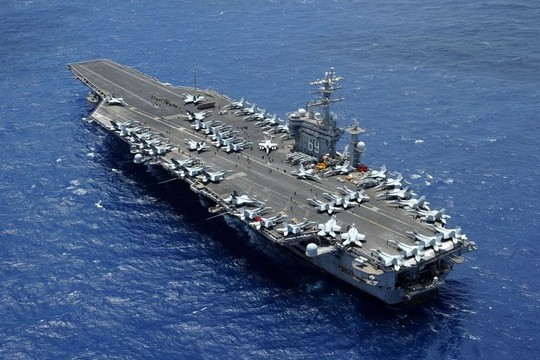US aircraft carrier.
Photo: Reuters
Will America slide into a brutal war it does not want? – Al Jazeera puts a question.
Strategically, the concentration of American forces in the Middle East risks leaving the US Navy without aircraft carriers in the Western Pacific, in a region where the largest US adversary, China, is located.
After several assassinations by the occupying power, most notably the operation against Ismail Haniyeh, the head of the political bureau of the Islamic Resistance Movement (Hamas), which took place on Iranian territory, fears about an Iranian reaction against Israel have increased, and the danger has grown that this could lead to the outbreak of a regional war, the outcome of which may be difficult to predict.
In such situations and in an atmosphere full of expectations, it seems natural for Washington to ensure its strategic goal, which is to ensure the security of Israel.
US officials have said that the army is redeploying its equipment and moving additional defense mechanisms towards the Middle East to counter any possible attack on Israel from the Iranian side.
The U.S. Department of Defense said it would deploy a squadron of warplanes to the Middle East, as well as additional cruisers and destroyers to the region. Defense Secretary Lloyd Austin also announced a near-complete redeployment of key naval ships, advanced fighter jets, and air defense systems.
As part of the effort, the U.S. Army announced Wednesday, Aug. 21, that the aircraft carrier USS Abraham Lincoln and its accompanying destroyers had arrived in the Middle East after Defense Secretary Lloyd Austin ordered the Naval Strike Group to move faster to the region.
In early August, the Washington Post reported that the United States had sent 12 warships to the Middle East, along with the giant aircraft carrier USS Theodore Roosevelt, which replaced the carrier Dwight D. Eisenhower, recently returned to the United States.
Three amphibious destroyers were also spotted in the eastern Mediterranean: the aircraft carrier USS Wasp, the aircraft carrier USS Oak Hill, and the aircraft carrier USS New York, as well as two destroyers, USS Bulkley and USS Roosevelt.
These moves appear to go beyond defensive policy and into offensive plans and potential strikes that the United States could launch against Iran or any other regional countries that could pose a threat to Israel.
At the same time, the United States is not addressing the dangerous consequences that the region is sliding into. The United States is also not addressing the genocide that is taking place in the Gaza Strip, the region’s hottest spot.
Strategically, the U.S. military’s concentration in the Middle East risks leaving the U.S. Navy without aircraft carriers in the Western Pacific, a region that contains the United States’ largest and most dangerous adversaries, as noted in a July Business Insider report.
The report says the USS Theodore Roosevelt’s deployment beyond the Western Pacific risks leaving a hole in the U.S. Navy’s plans in the region, while Russia and North Korea pose new challenges to U.S. ally South Korea. China has also been conducting demonstration missions using its carriers, with Chinese aircraft targeted at another U.S. ally, the Philippines. China has recently stepped up skirmishes with the Philippines in disputed waters off southern China Sea.
This is in line with Chinese naval activity. The carrier Shandong and a Chinese amphibious assault ship conducted exercises in the South China Sea in early July last year. China’s carriers are demonstrating the speed at which they are being built and deployed to the oceans as Beijing focuses on building a carrier fleet capable of projecting military power in the region and, potentially, around the world.
read more in our Telegram-channel https://t.me/The_International_Affairs

 11:38 27.08.2024 •
11:38 27.08.2024 •























